"Cherishing Little Steps - A Haven for Baby and Family Journeys"
Traveling Safely With Infants
Are you a parent or caregiver ready to hit the road with your little one?
Traveling safely with infants is a journey filled with joy, but it can also be a bit daunting. Don’t worry, though! With the right knowledge and preparation, you can embark on adventures with your precious bundle of joy with peace of mind.
From choosing the right travel gear to ensuring proper car seat installation, this guide will provide you with essential tips and tricks to keep your little one safe and secure while on the move.
So, let’s dive in and discover how you can navigate this exciting chapter of your life with confidence and intimacy.
Key Takeaways
- Ensuring proper car seat installation
- Planning for safe road trips
- Tips for navigating airport security
- Staying hygienic during travel
Choosing the Right Travel Gear
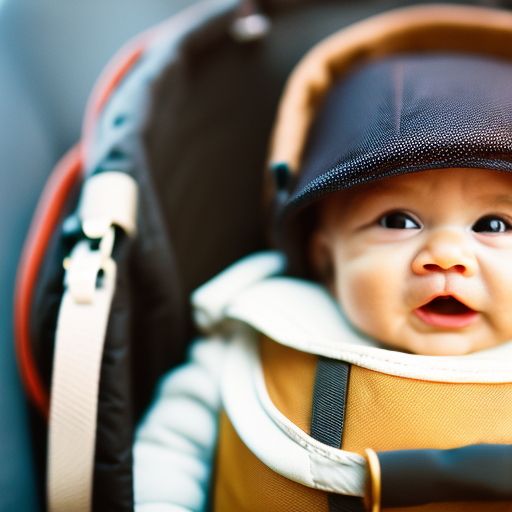
Choose travel gear that’s safe and suitable for your infant. When it comes to traveling with your little one, having the right gear is essential for both their safety and your convenience. One of the most important pieces of travel gear for infants is a stroller. When choosing the right stroller, there are a few key factors to consider.
First, make sure the stroller is lightweight and compact. This will make it easier for you to maneuver and transport while traveling. Look for strollers that are specifically designed for travel, as they’re often more lightweight and have features like a one-hand fold for easy storage.
Next, consider the safety features of the stroller. Look for models that have a five-point harness to securely hold your infant in place. It’s also important to choose a stroller with a sturdy frame and reliable brakes to ensure stability and prevent accidents.
Lastly, think about the functionality and convenience of the stroller. Look for features like a reclining seat, a large storage basket, and a sun canopy to provide comfort for your infant and make your travel experience easier.
Ensuring Proper Car Seat Installation
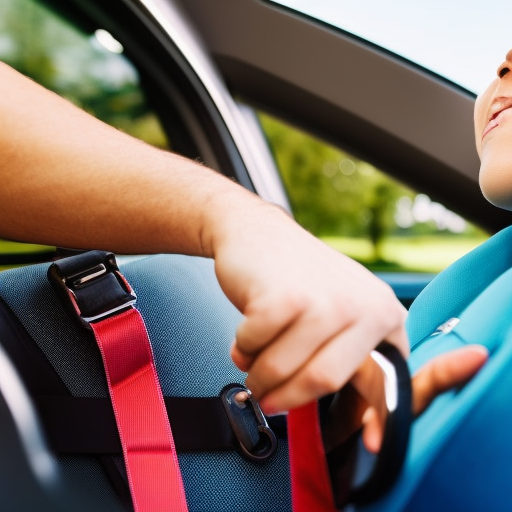
To ensure your infant’s safety while traveling, it’s crucial to properly install their car seat. Here are four important tips to help you ensure proper car seat installation:
-
Read the car seat manual: Before installing the car seat, carefully read the instruction manual provided by the manufacturer. This will give you detailed information on how to install the car seat correctly and securely.
-
Use the right installation method: There are different installation methods depending on the type of car seat and your vehicle. Make sure you’re using the correct method, whether it’s using the seat belt or the Lower Anchors and Tethers for Children (LATCH) system.
-
Check for a tight fit: After installing the car seat, give it a firm tug near the base to check for any movement. The car seat shouldn’t move more than an inch in any direction.
-
Avoid common car seat mistakes: Some common mistakes include loose harness straps, incorrect recline angle, and using expired car seats. Always double-check the harness straps, ensure the car seat is reclined at the proper angle, and check the expiration date of the car seat.
Planning for Safe Road Trips
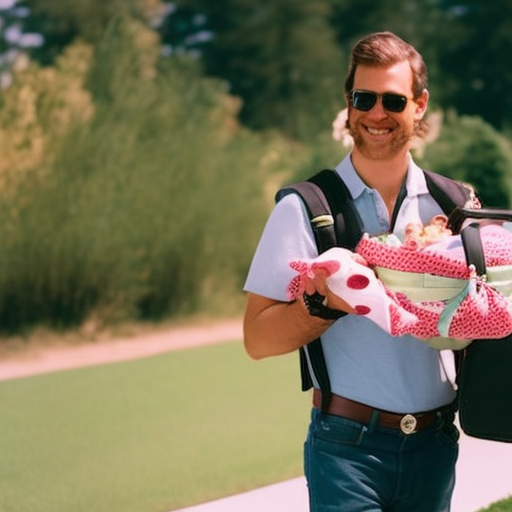
Prepare for a safe road trip with your infant by ensuring you have all the necessary supplies and a well-planned itinerary. When it comes to road trips with infants, it’s important to be prepared. Make sure you have plenty of road trip snacks on hand to keep your little one satisfied and happy throughout the journey. Pack a variety of healthy options such as sliced fruit, yogurt pouches, and cheese sticks. It’s also a good idea to bring along a spill-proof sippy cup filled with water or juice to keep your baby hydrated.
In addition to snacks, entertainment for infants is crucial to keep them engaged and entertained during the trip. Pack a bag with their favorite toys, such as soft books, rattles, and stuffed animals. You can also consider investing in a car seat toy or a mirror that attaches to the backseat so your baby can see their own reflection.
Having a well-planned itinerary is equally important for a safe road trip with your infant. Plan frequent breaks to allow for diaper changes, feeding, and stretching. Research family-friendly rest stops along your route so you can take breaks in a safe and comfortable environment.
Tips for Navigating Airport Security
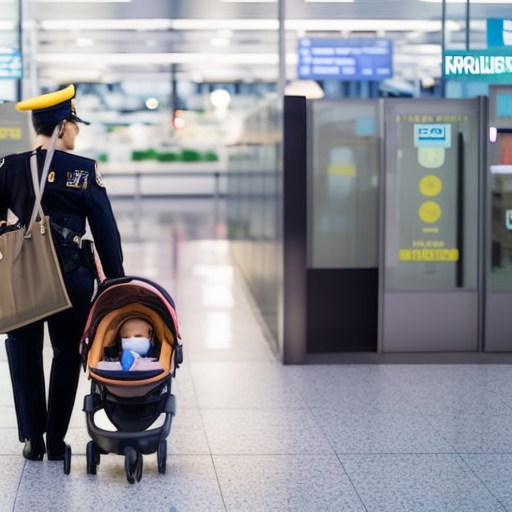
Navigating airport security with your infant can be made easier by familiarizing yourself with the process and following these helpful tips:
-
Prepare in advance: Before you even arrive at the airport, make sure you have all the necessary documents, such as your infant’s passport and your boarding passes, easily accessible. This will help streamline the security process and save you time and stress.
-
Pack smart: Organize your carry-on luggage in a way that allows for easy access to items you may need to remove during security checks, such as liquids, electronics, and baby food. Consider using clear, resealable bags to keep these items separate and visible.
-
Dress your infant comfortably: Opt for clothing that’s easy to remove and put back on, as your infant may need to go through additional screening. Avoid outfits with metal snaps or buttons that could set off the metal detectors.
-
Stay calm and soothing: Airport security checks can be overwhelming for infants. Bring along familiar toys or comfort items to help keep your baby calm during the process. Use a soothing voice and gentle touch to reassure your little one if they become anxious or upset.
Packing Essential Items for Infants

- Make sure you have all the essential items packed for your infant’s trip. Traveling with an infant requires careful planning and preparation. To ensure a smooth and stress-free journey, it is important to pack all the necessary items your little one will need. Here are some key essentials to consider:
| Clothing | Feeding | On-the-go |
|---|---|---|
| Comfortable and weather-appropriate outfits | Formula or breast milk | Bottles and nipples |
| Extra diapers and wipes | Bibs and burp cloths | Snacks and finger foods |
| Blankets and swaddles | Baby food or snacks | Sippy cups or spill-proof water bottles |
| Hats and sunscreen | Spoons and bowls | Portable high chair or booster seat |
| Changing pads | Portable bottle warmer | Diaper bag |
Choosing appropriate clothing for your infant is crucial for their comfort during the journey. Pack comfortable and weather-appropriate outfits, including hats and sunscreen for protection from the sun. Don’t forget to bring extra diapers, wipes, and changing pads to handle any unexpected messes.
Feeding on the go can be challenging, but with the right items, it can be made easier. Pack formula or breast milk, along with bottles, nipples, bibs, and burp cloths. If your infant is ready for solids, include baby food or snacks, spoons, and bowls. Sippy cups or spill-proof water bottles are also essential for hydration.
Lastly, consider the on-the-go essentials. Snacks and finger foods can help keep your little one entertained and satisfied during the journey. A portable high chair or booster seat can be useful when dining out or at your destination. Don’t forget to pack a well-stocked diaper bag with all the necessary items, including extra clothes, diapers, wipes, and any medication your infant may need.
Staying Hygienic During Travel
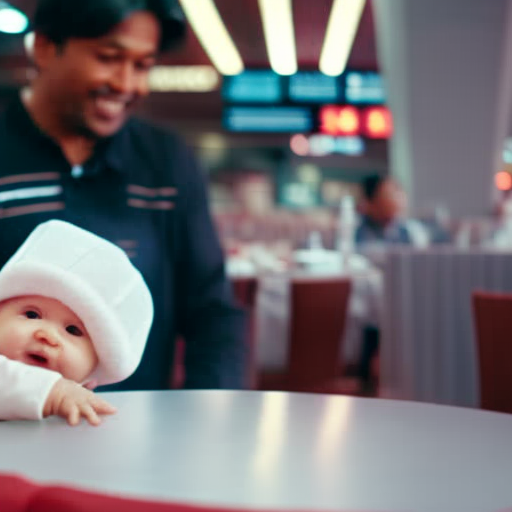
To maintain cleanliness and prevent the spread of germs while traveling with your infant, prioritize hygiene practices. Here are four tips to help you stay hygienic during your journey:
-
Wash your hands frequently: Keeping your hands clean is crucial for preventing illness. Use soap and water for at least 20 seconds, especially before and after handling your baby, feeding, or changing diapers. If soap and water aren’t available, use a hand sanitizer with at least 60% alcohol.
-
Pack disinfecting wipes: Wipe down surfaces that your baby may come into contact with, such as tray tables, armrests, and high chairs. Disinfecting wipes can help eliminate germs and keep your little one safe from harmful bacteria.
-
Bring a portable changing mat: Changing diapers on public surfaces can expose your baby to germs. Use a portable changing mat to create a clean and hygienic space for diaper changes, ensuring your baby’s comfort and reducing the risk of infection.
-
Avoid crowded places: Minimizing your baby’s exposure to crowded areas can help reduce the chances of catching an illness. Consider traveling during off-peak hours and avoid overcrowded spaces whenever possible.
Creating a Comfortable Sleeping Environment
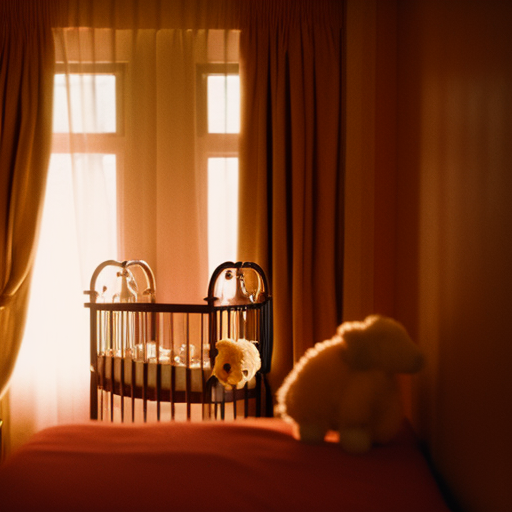
Ensure your infant sleeps comfortably by setting up a cozy and secure sleeping environment. A comfortable bedding is essential for your baby’s sleep quality. Choose a crib or bassinet that’s sturdy and meets safety standards. Make sure it has a firm mattress with a fitted sheet. Avoid using pillows, blankets, or stuffed animals in the crib, as they can pose suffocation risks. Instead, dress your baby in appropriate sleepwear to keep them warm.
Establishing a consistent sleep routine can also contribute to a comfortable sleep environment. Babies thrive on routine, so try to create a predictable schedule for naps and bedtime. This can include activities like a warm bath, soothing music, or a bedtime story. Keep the room dimly lit and at a comfortable temperature. You may also consider using a white noise machine to drown out any external sounds that may disturb your baby’s sleep.
Dealing With Jet Lag and Time Zone Changes
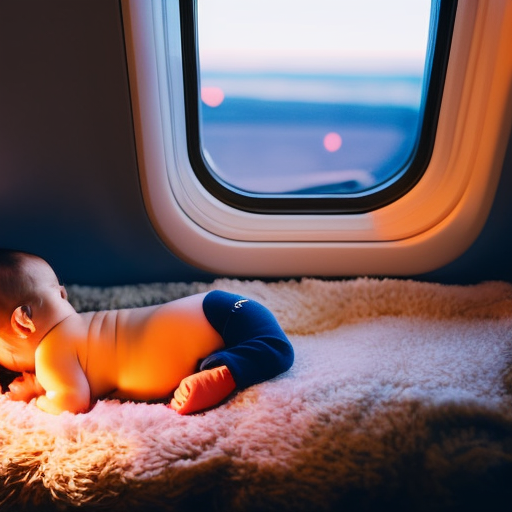
Adjusting your infant’s sleep schedule to new time zones can be challenging, but with some simple strategies, you can help minimize the effects of jet lag. Dealing with jet lag and adjusting to new time zones can disrupt your infant’s sleep patterns and make them feel disoriented. To make this transition smoother, try the following strategies:
-
Gradual adjustment: Start adjusting your infant’s sleep schedule a few days before your trip. Gradually shift their bedtime and wake-up time closer to the new time zone.
-
Natural light exposure: Expose your infant to natural light during the day and minimize exposure to artificial light at night. This helps regulate their internal body clock.
-
Stick to routine: Maintain your infant’s regular sleep routine as much as possible. Familiarity and consistency can help them feel more secure and adapt to the new time zone.
-
Nap strategically: Encourage short naps during the day to prevent overtiredness, but avoid long naps close to bedtime, as they may disrupt sleep at night.
Preparing for Emergency Situations
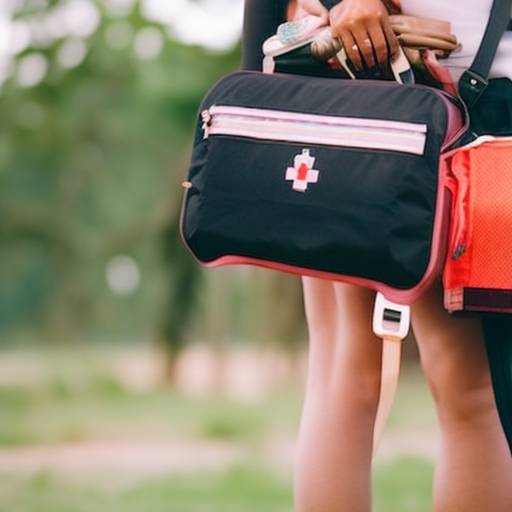
In case of emergency, it is important to be prepared when traveling with infants. When it comes to emergency situations, such as natural disasters or accidents, having a plan in place and equipping yourself with the necessary tools can make all the difference. Two key elements to consider are emergency evacuation and first aid kits.
Emergency Evacuation
In the event of an emergency, it is crucial to have a plan for evacuating safely with your infant. Familiarize yourself with the emergency exits and evacuation procedures of your accommodation. Keep a list of emergency contacts, including local authorities and medical facilities. Additionally, consider packing a small bag with essential items like extra diapers, formula, and a change of clothes for your baby.
First Aid Kits
A well-stocked first aid kit can be a lifesaver in emergency situations. Make sure your kit includes items such as band-aids, gauze pads, adhesive tape, antiseptic wipes, and fever-reducing medication suitable for infants. It is also advisable to carry any necessary prescription medications your infant may need.
To help you visualize the essentials for emergency situations, here is a simple table outlining the items you should consider including in your emergency evacuation plan and first aid kit:
| Emergency Evacuation | First Aid Kit |
|---|---|
| Familiarize yourself with emergency exits | Band-aids |
| Know evacuation procedures | Gauze pads |
| Keep a list of emergency contacts | Adhesive tape |
| Pack essential items for your baby | Antiseptic wipes |
| Fever-reducing medication | |
| Prescription medications |
Tips for Traveling With Infants on Public Transport
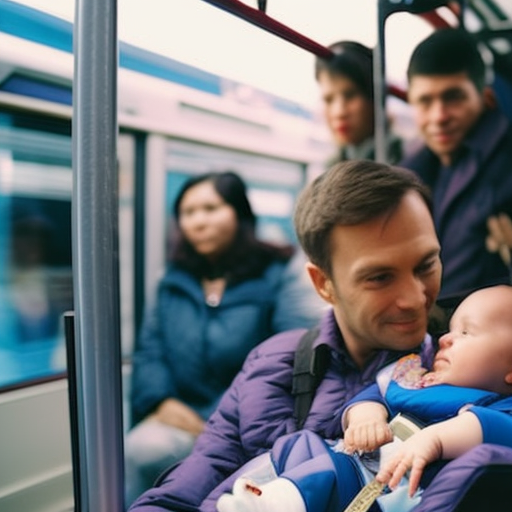
When traveling with infants, it’s important to know how to navigate public transport safely and comfortably. Here are some tips to help you have a smooth journey with your little one:
-
Choosing appropriate seating: Opt for seats near the entrance or exit of the vehicle to easily board and disembark with your infant. Additionally, look for seats with extra legroom or designated spaces for strollers, as this can make your journey more comfortable.
-
Ensuring proper infant carrier: Invest in a secure and comfortable infant carrier that meets safety standards. Ensure that it’s properly installed and adjusted to fit your baby snugly. This will provide support and keep your baby safe during the journey.
-
Bringing necessary supplies: Pack essential supplies such as diapers, wipes, bottles, and extra clothing in a diaper bag. Having these items readily accessible will help you handle any unexpected situations that may arise during your trip.
-
Being mindful of the schedule: Check the schedule and plan your journey around your baby’s feeding and nap times. This will help minimize disruptions and ensure a more pleasant experience for both you and your infant.
Managing Infant Travel Anxiety
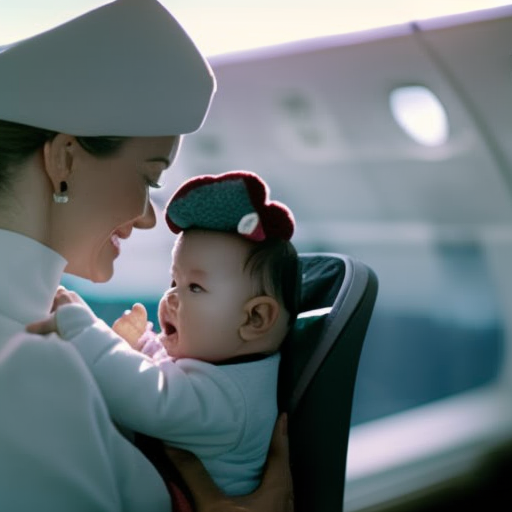
To manage infant travel anxiety, ensure you have prepared your little one for the journey ahead. Managing separation anxiety is crucial during travel. Start by gradually exposing your baby to short periods of separation, such as leaving them with a trusted caregiver. This will help them build resilience and develop a sense of security. Additionally, bringing along familiar items like their favorite blanket or stuffed animal can provide comfort and reassurance.
Coping with motion sickness is another aspect to consider. Keep in mind that infants are more prone to motion sickness due to their developing inner ear. To minimize discomfort, try to plan your travel during their nap times or when they’re most likely to be calm. If your little one experiences motion sickness, offer small, frequent meals and avoid heavy or greasy foods before and during the journey. Also, make sure to keep the vehicle well-ventilated and provide distractions such as toys or music to divert their attention.
Making the Most of Traveling With Infants

Maximize your experience traveling with infants by incorporating fun and engaging activities.
Traveling with infants can be challenging, but with careful planning and preparation, it can also be an opportunity for bonding and creating lasting memories. Here are some ideas to make the most of your travels with your little one:
-
Create a travel journal: Document your journey by keeping a travel journal. Include photos, ticket stubs, and write about your experiences. This won’t only be a wonderful keepsake but also a great way to engage your infant and stimulate their sensory development.
-
Play interactive games: Pack small toys and games that are easy to carry and can be played on the go. Peek-a-boo, finger puppets, and sensory toys are great options to entertain your infant during travel.
-
Explore local parks and attractions: Research child-friendly parks or attractions at your destination. Take your infant to these places to let them explore and engage with their surroundings. This won’t only provide them with new sensory experiences but also give you a chance to relax and enjoy the moment.
-
Connect with other parents: Reach out to local parent groups or join online forums to connect with other parents who are traveling with infants. They can provide valuable tips and advice specific to your destination, making your experience smoother and more enjoyable.
Frequently Asked Questions
What Are the Best Travel Destinations for Infants?
You want to know the best travel destinations for infants. Well, when it comes to traveling with your little one, it’s crucial to consider the best travel gear and tips for traveling on a budget.
How Can I Keep My Infant Entertained During Long Flights?
To keep your infant entertained during long flights, bring along some travel toys specifically designed for infants. Additionally, try these tips for traveling with a fussy baby to ensure a smoother journey.
Are There Any Restrictions or Guidelines for Traveling With Breast Milk or Formula?
When traveling with breast milk or formula, it’s important to be aware of any restrictions or guidelines. Taking infant safety precautions is crucial to ensure you are traveling safely with your little one.
How Can I Prevent My Infant From Getting Motion Sickness During Car Rides?
To prevent your infant from getting motion sickness during car rides, there are a few tips you can follow. Make sure they have a light meal before traveling, keep the car well-ventilated, and have them sit in a rear-facing car seat.
Are There Any Specific Safety Measures to Take When Traveling With Infants During the COVID-19 Pandemic?
When traveling with infants during the COVID-19 pandemic, it’s important to take specific safety measures. Ensure the safety of your little one by following guidelines, such as practicing good hygiene, maintaining social distance, and wearing masks when necessary.
Conclusion
In conclusion, traveling safely with infants requires careful planning and preparation.
By choosing the right travel gear, ensuring proper car seat installation, and packing essential items, you can ensure your infant’s safety and comfort on the go.
Additionally, being prepared for emergency situations and managing travel anxiety will help make your journey smoother.
Remember, with the right strategies and precautions in place, traveling with infants can be a rewarding and enjoyable experience for both parents and children.



Your article helped me a lot, is there any more related content? Thanks!